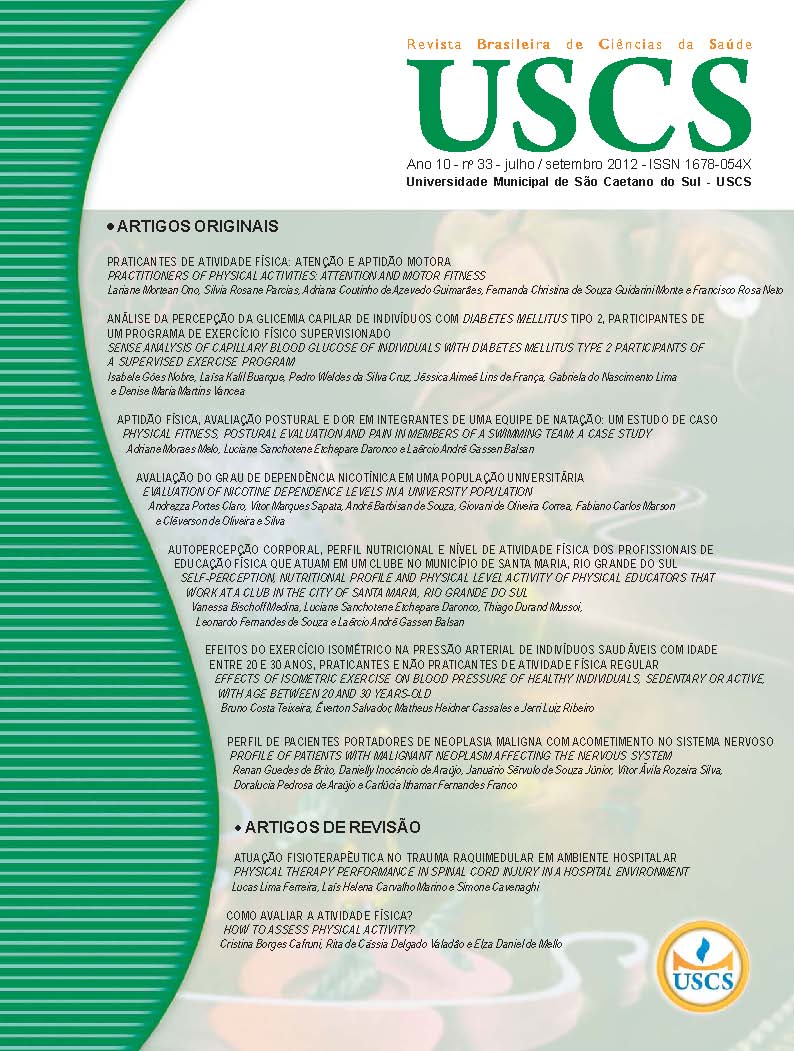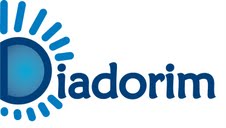Efeitos do Exercício Isométrico na Pressão Arterial de Indivíduos Saudáveis com Idade Entre 20 e 30 Anos Praticantes e Não-Praticantes de Atividade Física Regular
DOI:
https://doi.org/10.13037/rbcs.vol10n33.1529Keywords:
Exercício isométrico, Pressão arterial, Frequência cardíacaAbstract
Objetivo: Verificar os efeitos do exercício isométrico nas variáveis cardiovasculares (FC e PA) de indivíduos saudáveis sedentários ou praticantes de atividade física. Métodos: Trinta homens foram divididos nos grupos sedentário, aeróbio e anaeróbio, que realizaram 4 ações musculares isométricas de 30 segundos a 70% de 1RM do quadríceps num ângulo de 135° de extensão do joelho. As diferenças entre os momentos (repouso, durante, imediatamente após, 5 min após) foram analisadas pelo teste ANOVA para medidas repetidas, com Post Hoc de Bonferoni. A diferença entre os grupos foi analisada pelo teste ANOVA fatorial com post hoc de Tukey. Resultados: Não houve diferença significativa entre os 3 grupos no que diz respeito à idade, peso, estatura, 1 RM, IMC, a porcentagem de gordura, peso de gordura e massa magra. Houve diferença significativa com relação a PAM comparando os grupos sedentário, aeróbio e anaeróbio nos momentos antes, durante, imediatamente após e 5 min após, assim como nos resultados da FC. Conclusão: O exercício isométrico alterou as variáveis cardiovasculares nos grupos sedentário, aeróbio e anaeróbio. Entretanto com relação à pressão arterial média o grupo anaeróbio só demonstrou alteração significante 5 min após o termino do exercício, provavelmente pela adaptação provocada pelo maior componente isométrico do seu tipo de treinamento.
Downloads
References
(1) Akdur H, Yigit Z, Arabaci U, Polat MG, Gürses HN, Güzelsoy D. Comparison of cardiovascular responses to isometric (static) and isotonic (dynamic) exercise tests in chronic atrial fibrillation. Jpn Heart J. 2002 Nov; 43(6):621-9.
(2) Fleck SJ, Kraemer W. Fundamentos do treino de força muscular. 3. ed. Porto Alegre: Artmed: 2006.
(3) Morrisey MC. The relationship between peak torque and work of the quadriceps and hamstrings after meniscectomy. J Orthop Sports Phys Ther. 1987; 8(8):405-8.
(4) Sherman WM, Pearson DR, Plyley MJ, Costill DL, Habansky AJ, Vogelgesang DA. Isokinetic rehabilitation after surgery. A review of factors which are important for developing physiotherapeutic techniques after knee surgery. Am J Sports Med. 1982 May/Jun; 10(3):155-61.
(5) Thomeé R, Renstrom P, Grimby G, Peterson L. Slow or fast isokinetic training after – knee ligament surgery*. J Orthop Sports Phys Ther. 1987; 8(10):475-9.
(6) Iellamo F, Legramante JM, Raimondi G, Castrucci F, Damiani C, Foti C et al. Effects of isokinetic, isotonic and isometric submaximal
exercise on heart rate and blood pressure. Eur J Appl Physiol Occup Physiol. 1997; 75(2):89-96.
(7) Taylor AC, McCartney N, Kamath MV, Wiley RL. Isometric training lowers resting blood pressure and modulates autonomic control. Med Sci Sports Exerc. 2003 Feb; 35(2):251-6.
(8) Wiley RL, Dunn CL, Cox RH, Hueppchen NA, Scott MS. Isometric exercise training lowers resting blood pressure. Med Sci Sports Exerc.
1992 Jul; 24(7):749-54.
(9) Urata H, Tanabe Y, Kiyonaga A, Ikeda M, Tanaka H, Shindo M et al. Antihypertensive and volume-depleting effects of mild exercise on
essential hypertension. Hypertension. 1987 Mar; 9(3):245-52.
(10) Véras-Silva AS, Mattos KC, Gava NS, Brum PC, Negrao CE, Krieger EM. Low-intensity exercise training decreases cardiac output and
hypertension in spontaneously hypertensive rats. Am J Physiol. 1997 Dec; 273(6 Pt 2):H2627-31.
(11) Hagberg JM, Montain SJ, Martin WH 3rd, Ehsani AA. Effect of exercise training in 60- to 69-year-old persons with essential hypertension. Am J Cardiol. 1989 Aug; 64(5):348-53.
(12) Brum PC, Forjaz CLM, Tinucci T, Negrão CE. Adaptações agudas e crônicas do exercício físico no sistema cardiovascular. Rev Paul
Educ Fís. 2004 ago; 18(n. esp.):21-31.
(13) Rondon MUPB, Brum PC. Exercício físico como tratamento não farmacológico da hipertensão arterial. Rev Bras Hipertens. 2003 abr/ jun; 10(2):134-9.
(14) Negrão CE, Rondon MUPB, Kuniyosh FHS, Lima EG. Aspectos do treinamento físico na prevenção da hipertensão arterial. Rev Hipertensão. 2001; 4(3).
(15) Teixeira JAC. Hipertensão arterial sistêmica e atividade física. Rev Socerj. 2000 out/nov/ dez; 13(4):25-30.
(16) Silverthorn DU. Fisiologia humana – uma abordagem integrada. Barueri: Manole; 2003.
(17) Grassi G, Seravalle G, Calhoun DA, Mancia G. Physical training and baroreceptor control of sympathetic nerve activity in humans.
Hypertension. 1994 Mar; 23(3):294-301.
(18) Pássaro LC, Godoy M. Reabilitação cardiovascular na hipertensão arterial. Rev Socesp. 1996; 6:45-58.
(19) Forjaz CLM, Santaella DF, Rezende LO, Barretto ACP, Negrão CE. Duração do exercício determina a magnitude e a duração da
hipotensão pós-exercício. Arq Bras Cardiol. 1998; 70(2):99-104.
(20) Cléroux J, Yardley C, Marshall A, Coulombe D, Lacourcière Y. Antihypertensive and hemodynamic effects of calcium channel
blockade with isradipine after acute exercise. Am J Hypertens. 1992 Feb; 5(2):84-7.
(21) Halliwill JR, Taylor JA, Eckberg DL. Impaired sympathetic vascular regulation in humans after acute dynamic exercise. J Physiol. 1996 Aug; 495(Pt 1):279-88.
(22) Piepoli M, Coats AJ, Adamopoulos S, Bernardi L, Feng YH, Conway J et al. Persistent peripheral vasodilation and sympathetic activity
in hypotension after maximal exercise. J Appl Physiol. 1993 Oct; 75(4):1.807-14.
Downloads
Published
Issue
Section
License
Copyright (c) 2012 Bruno Costa Teixeira, Everton Salvador, Matheus Heidner Cassales, Jerri Luiz Ribeiro

This work is licensed under a Creative Commons Attribution-NonCommercial-NoDerivatives 4.0 International License.
Policy Proposal for Journals offering Free Delayed Access
Authors who publish in this magazine agree to the following terms:
- Authors maintain the copyright and grant the journal the right to the first publication, with the work simultaneously licensed under a Creative Commons Attribution License after publication, allowing the sharing of the work with recognition of the authorship of the work and initial publication in this journal.
- Authors are authorized to assume additional contracts separately, for non-exclusive distribution of the version of the work published in this magazine (eg, publishing in institutional repository or as a book chapter), with the acknowledgment of the authorship and initial publication in this journal.
- Authors are allowed and encouraged to publish and distribute their work online (eg in institutional repositories or on their personal page) at any point before or during the editorial process, as this can generate productive changes, as well as increase impact and citation of the published work (See The Effect of Open Access).









